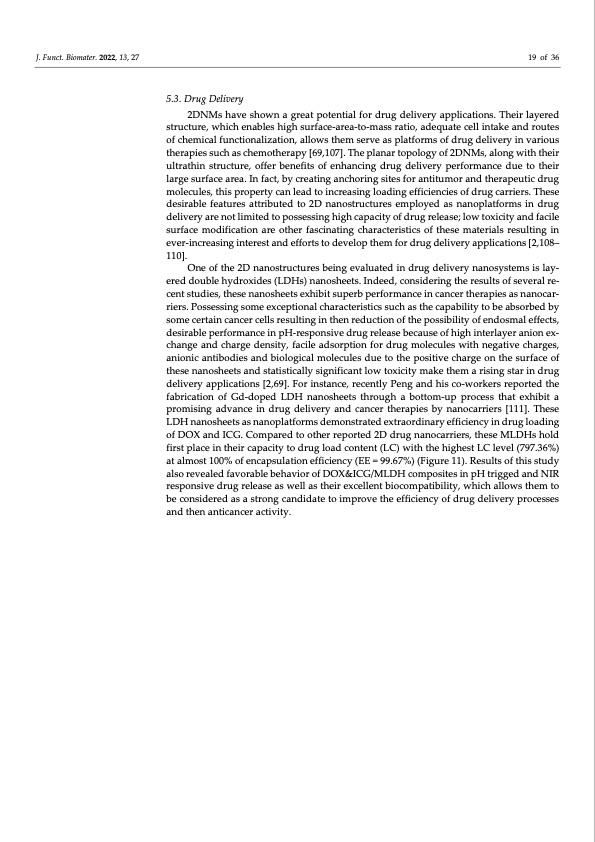
PDF Publication Title:
Text from PDF Page: 019
J. Funct. Biomater. 2022, 13, 27 19 of 36 5.3. Drug Delivery 2DNMs have shown a great potential for drug delivery applications. Their layered structure, which enables high surface-area-to-mass ratio, adequate cell intake and routes of chemical functionalization, allows them serve as platforms of drug delivery in various therapies such as chemotherapy [69,107]. The planar topology of 2DNMs, along with their ultrathin structure, offer benefits of enhancing drug delivery performance due to their large surface area. In fact, by creating anchoring sites for antitumor and therapeutic drug molecules, this property can lead to increasing loading efficiencies of drug carriers. These desirable features attributed to 2D nanostructures employed as nanoplatforms in drug delivery are not limited to possessing high capacity of drug release; low toxicity and facile surface modification are other fascinating characteristics of these materials resulting in ever-increasing interest and efforts to develop them for drug delivery applications [2,108– 110]. One of the 2D nanostructures being evaluated in drug delivery nanosystems is lay- ered double hydroxides (LDHs) nanosheets. Indeed, considering the results of several re- cent studies, these nanosheets exhibit superb performance in cancer therapies as nanocar- riers. Possessing some exceptional characteristics such as the capability to be absorbed by some certain cancer cells resulting in then reduction of the possibility of endosmal effects, desirable performance in pH-responsive drug release because of high interlayer anion ex- change and charge density, facile adsorption for drug molecules with negative charges, anionic antibodies and biological molecules due to the positive charge on the surface of these nanosheets and statistically significant low toxicity make them a rising star in drug delivery applications [2,69]. For instance, recently Peng and his co-workers reported the fabrication of Gd-doped LDH nanosheets through a bottom-up process that exhibit a promising advance in drug delivery and cancer therapies by nanocarriers [111]. These LDH nanosheets as nanoplatforms demonstrated extraordinary efficiency in drug loading of DOX and ICG. Compared to other reported 2D drug nanocarriers, these MLDHs hold first place in their capacity to drug load content (LC) with the highest LC level (797.36%) at almost 100% of encapsulation efficiency (EE = 99.67%) (Figure 11). Results of this study also revealed favorable behavior of DOX&ICG/MLDH composites in pH trigged and NIR responsive drug release as well as their excellent biocompatibility, which allows them to be considered as a strong candidate to improve the efficiency of drug delivery processes and then anticancer activity.PDF Image | Nanomaterials beyond Graphene for Biomedical Applications

PDF Search Title:
Nanomaterials beyond Graphene for Biomedical ApplicationsOriginal File Name Searched:
jfb-13-00027.pdfDIY PDF Search: Google It | Yahoo | Bing
CO2 Organic Rankine Cycle Experimenter Platform The supercritical CO2 phase change system is both a heat pump and organic rankine cycle which can be used for those purposes and as a supercritical extractor for advanced subcritical and supercritical extraction technology. Uses include producing nanoparticles, precious metal CO2 extraction, lithium battery recycling, and other applications... More Info
Heat Pumps CO2 ORC Heat Pump System Platform More Info
| CONTACT TEL: 608-238-6001 Email: greg@infinityturbine.com | RSS | AMP |